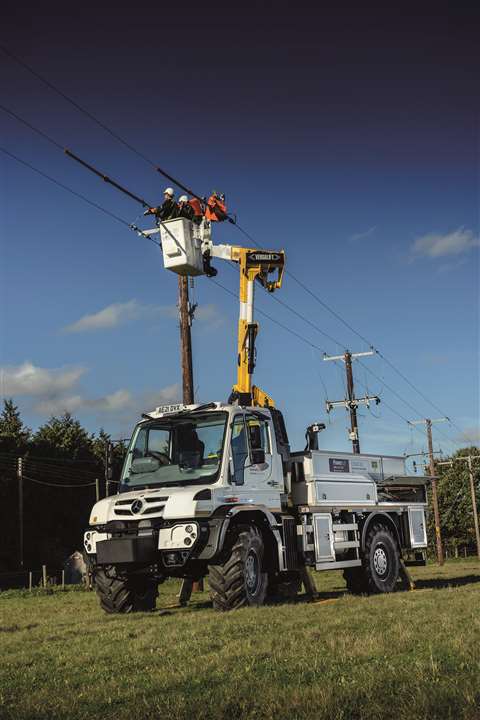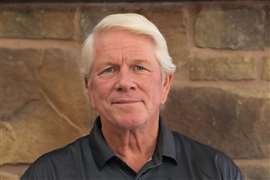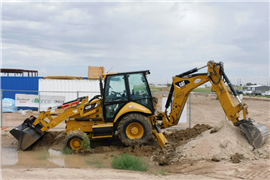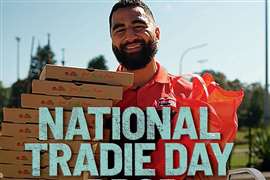EU electrical hazard policy impossible to deliver, says Access sector
23 August 2022
The access industry has reacted with surprise to a clause in the draft of the new EU European Machinery Regulations that requires all mobile machinery to be designed to prevent contact with overhead power lines or, where the risk cannot be avoided, designed to ensure that all electrical hazards are prevented.
 A platform mounted Unimog U530 carrying out maintenance work for UK Power Networks
A platform mounted Unimog U530 carrying out maintenance work for UK Power Networks
Industry experts say they will support any practical measures to improve safety, but such measures are impossible to deliver.
The concerns, first highlighted by ESTA - Europe’s crane and specialized transport association - focus on a proposal in Annex III, Part 3, point 3.5.4. of the draft document.
The clause states that when the risk of contact or electric arc from an overhead power line to a machine operator cannot be avoided, then machinery should be designed to prevent any electrical hazards.
Industry reacts
Luisa Parisotto, Senior Regulatory and Compliance Manager for Genie and MEWPs Product Group President for FEM, the European Materials Handling Federation, speaking to ESTA, said, “Inside FEM it came as a surprise, I am not aware of any consultation held before on this specific point.
“It was immediately clear that this requirement, as written, would have made it impossible to continue to design MEWPs in the way we do.
“As FEM we expressed our concerns from the beginning, through our position papers and comments on the drafted amendments circulated in the past months.”
As currently drafted, the regulations would effectively forbid the production or import of mobile machinery as no technical solutions exist that would allow the regulations’ requirements to be met.
If agreed, the European Machinery Regulations will update the existing Machinery Directive, which came into force in 2006.
The manufacturers and their customers have pointed out that mobile machinery has to reach heights beyond power lines to carry out work, and that machines have to be built using metal, which conducts electricity.
ESTA has requested a response to its concerns from the European Commission.
IPAF response
Resistance to the clause has come from across industry. As a member of the FEM MEWPs Product Group, IPAF said it fully supported Parisotto in her statement and concerns raised in response to the proposed new clause.
Brian Parker, IPAF Head of Safety and Technical, who represents the Federation on the FEM MEWP group and the commented, “The proposal to prevent electrical contact with overhead powerlines through the design of machinery is not possible to meet, as MEWPS, by virtue of their design, are versatile machinery intended to get people and their materials to a working height in a multitude of environments. It is simply not possible to meet the intended use and avoid all hazards through machine design only.
Parker added, “Electrical hazards are environmental in nature and must be managed by safe use, task-based risk assessments and safe systems of work which is no different to ground conditions or working near public highways. The draft Machinery Regulation should be reviewed with this context in mind.”
Through its global accident reporting portal IPAF has identified electrocution as the second highest cause of fatalities while working at height using MEWPs. “While we as an industry must do more to reduce these fatal and serious incidents IPAF does not support that this can be addressed only by machinery design. IPAF, with its members, is supporting the industry through safety campaigns, guidance material and training to highlight the hazards and risks when working around overhead power lines, and emphasizes the need for a safe system of work and suitable risk assessment,” said Parker.
Parker also noted that the proposed amendment has the potential to impact all plant machinery that can lift materials or persons to work at height, making the issue broader than cranes and MEWPs.
Impossible demands
Markus Golder overall chair of CEN/TC 147 (the safety standards committee of the European Committee for Standardisation) and a Professor at the Faculty for Mechanical Engineering at Chemnitz University of Technology in Germany, said; “It is not possible to design such a crane to prevent the risk of contact with an energised overhead power line.
“There are no systems available that can reliably detect live power lines, and therefore such cranes cannot be ‘constructed and equipped in such a way that all hazards of an electrical nature are prevented’”.
Genie’s Parisotto agreed with Professor Golder that the way to improve safety is through effective and professional site management, common standards and high-quality training – not by making impossible demands on the equipment manufacturers and their clients.
”It is technically not possible to design mobile machinery including mobile elevated work platforms, telehandler and cranes, in a way that prevents all electrical hazards associated with contact or arcing from overhead powerlines”, said Parisotto.
“MEWPs are designed to bring operators to an elevated position from where they can carry out their work. By definition the machine is not linked to a specific use, site or environment. On the contrary, it is a versatile machine which can be used for many different purposes and in many different environments.
“Therefore, it makes no sense imposing, by design, such a requirement, which should be addressed by a proper jobsite risk assessment undertaken by the employers.”
Golder has asked that the relevant section be deleted from the draft regulations, adding that the potential impact of such a regulation would be enormous and would affect the performance of many important tasks, such the erection or maintenance of wind power turbines and railway construction.
The Machinery Directive is one of the main pieces of legislation governing the harmonisation of health and safety requirements for machinery throughout the EU and is intended to promote the free movement of machinery within the single market as well as ensuring a high level of protection for workers and the public.
STAY CONNECTED



Receive the information you need when you need it through our world-leading magazines, newsletters and daily briefings.
CONNECT WITH THE TEAM











